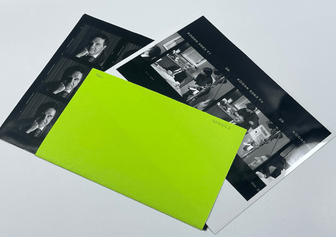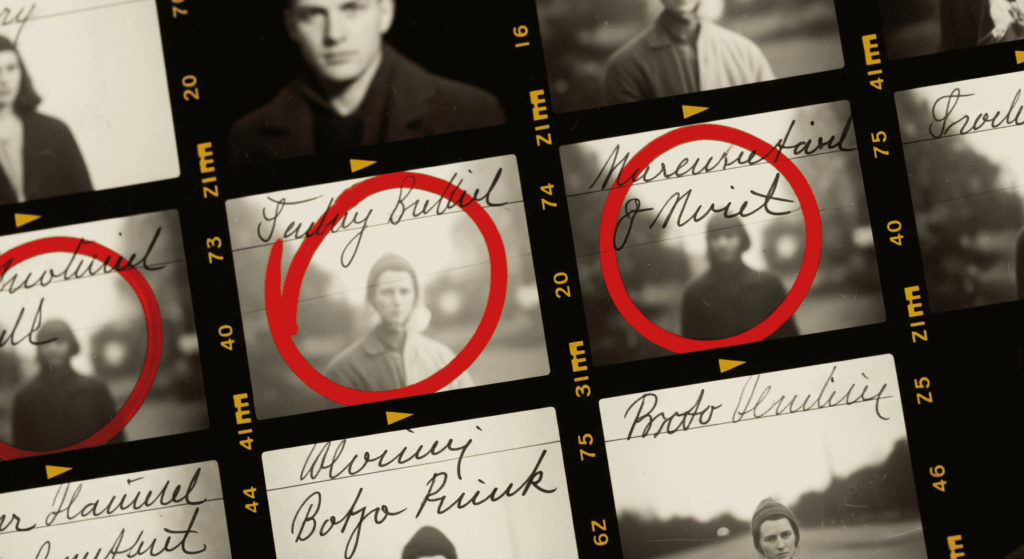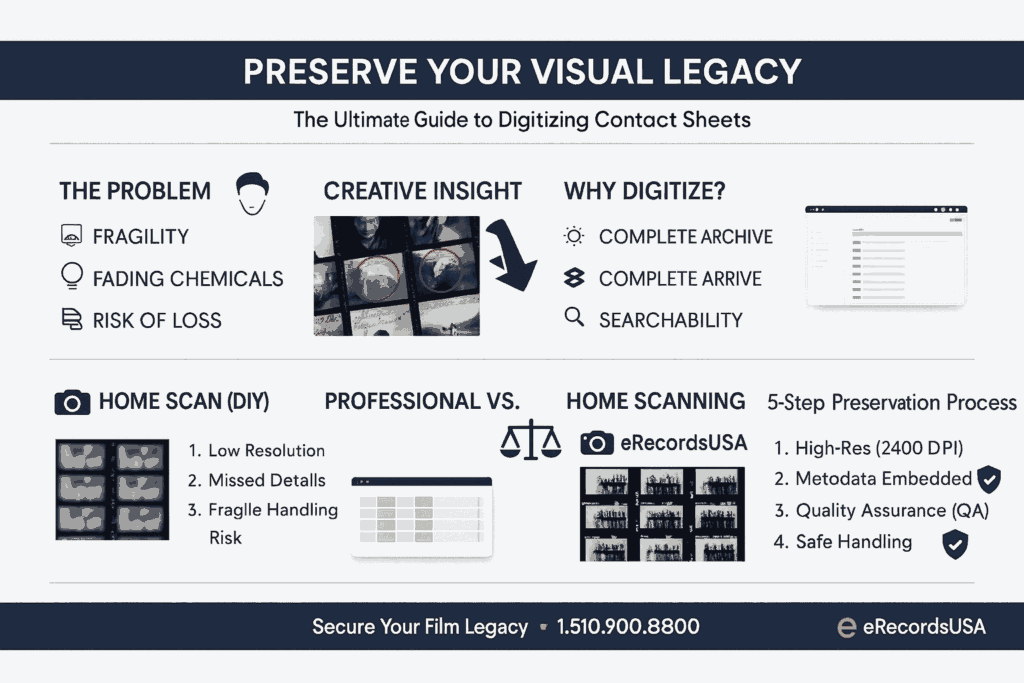Imagine losing an entire photo shoot because a single piece of paper faded away. For decades, contact sheets were the photographer’s blueprint—a single page displaying every frame from a roll of film.
Today, these grid-like sheets are more than just tools; they are fragile historical records filled with creative decisions and personal memories. But they are in danger. Paper tears, chemicals fade, and without professional film digitization, these archives could vanish forever.
Whether you are a museum archivist or a photographer with boxes of old negatives, this guide covers exactly how to protect your collection
According to market research, the global demand for film and photo digitization is rising steadily as more people aim to protect their analog collections [source].
What is a Contact Sheet & Why Are They Critical for Archives?
Strictly defined, a contact sheet is a single page that displays every photo from a specific roll of film, arranged in a neat grid.
The Evolution: From Darkroom to Digital
Historically, these were the backbone of analog photography. Photographers created them in darkrooms by placing film negatives directly onto photographic paper, exposing them to light, and developing the sheet. The result was a “contact” print showing tiny, positive versions of every shot.
Today, the concept survives in the digital workflow. Photographers use software like Adobe Lightroom or Photoshop to create digital contact sheets, viewing thumbnails side-by-side to simulate the analog experience.
Why Archivists & Photographers Still Value Them?
Even in the digital age, vintage contact sheets are considered distinct archival records. They offer unique data that individual photo prints cannot:
- Creative Insight: They reveal the photographer’s thought process—specifically how they approached a subject, framed it, and selected the final image.
- A Complete Record: Unlike a curated photo album, a contact sheet preserves every frame, ensuring that rejected or “B-roll” images are not lost to history.
- The “Map” of the Archive: Contact sheets often feature handwritten notes, grease pencil circles, dates, and roll numbers. These markings connect images to specific events, making them indispensable for organizing physical and digital archives.
The Risk: Despite their value, paper contact sheets do not last forever. They fade, tear, and suffer from chemical breakdown over time. This fragility makes digitization not just an option, but a necessity for preservation.
Why Professional Digitization Beats Home Scanning?
You might have a scanner at home, but digitizing contact sheets requires more than just generic equipment. These sheets are often fragile and contain subtle details—faint pencil marks, exposure notes, and film edge numbers—that consumer scanners frequently miss.
Here is why photographers and archivists trust professional services like eRecordsUSA over DIY methods:
1. Capturing the “Invisible” Details
A contact sheet is a working document. The value often lies in the handwritten notes and “marginalia” scribbled by the photographer. Professional digitization uses high-grade flatbed scanners capable of 600–2400 dpi. This resolution ensures that every grease pencil mark, frame number, and contrast variation is captured with absolute sharpness.
2. Embedded Metadata for Searchability
A digital scan is useless if you can’t find it later. Unlike a simple “scan and save” process, professional digitization includes metadata embedding. We tag files with critical data—such as shoot dates, photographer names, and roll numbers—making your digital archive fully searchable and easy to sort.
Example: Instead of Scan001.jpg, your file becomes 2024-Wedding-Roll05_ContactSheet.tif, complete with copyright info embedded inside.
3. Specialized Handling for Fragile Media
Old contact sheets are sensitive to oils and handling. We utilize strict preservation protocols, including the use of lint-free gloves, anti-static cleaning tools, and acid-free sleeves. This ensures that the digitization process itself never harms your delicate originals.
4. Future-Proof File Formats
We don’t just give you a picture; we give you an asset. You receive uncompressed TIFF files for long-term archival preservation, alongside high-resolution JPEGs for easy web sharing. This ensures your records are protected against data loss or format obsolescence for decades to come.
How We Digitize: A Secure, 5-Step Preservation Process
At eRecordsUSA, we don’t just scan documents; we preserve history. Our workflow is designed to handle rare and fragile materials with the highest level of security and precision. Here is exactly what happens when you entrust us with your collection:
Step 1: Safe Handling & Preparation
Every project begins with safety. We carefully unpack and review each contact sheet using lint-free gloves to prevent oils or fingerprints from transferring to the paper. Before scanning, we use specialized anti-static tools to gently clean dust from the surface, ensuring a pristine capture without risking scratches.
Step 2: High-Resolution Scanning
We utilize professional-grade flatbed and transparency scanners tailored to the specific condition of your sheets.
- Resolution: Scans are performed at 600–2400 dpi to capture fine details like film grain and edge markings.
- Formats: We output files in your preferred format, including Archival TIFF (for preservation), JPEG (for web use), or PDF.
Step 3: Metadata & File Organization
A scan is only useful if you can find it. We employ a structured naming convention and embed rich metadata directly into the file. This includes the shoot date, photographer’s name, subject keywords, and copyright information. This step ensures your digital files remain searchable and connected to their original film rolls forever.
Step 4: Quality Assurance (QA)
We do not rely solely on automation. Our technicians manually check every scan for alignment, sharpness, and color fidelity. If a scan does not meet archival standards, we adjust the settings and re-scan immediately.
Step 5: Secure Delivery & Backup
Once approved, your files are delivered via secure cloud platforms like Google Drive or Dropbox. This allows for immediate access while ensuring you have a redundant digital backup of your physical archive.
Best Practices: How to Preserve Contact Sheets (Physical & Digital)
Digitization ensures your images survive, but maintaining the original “masters”—both the physical paper and the new digital files—is equally important. Here are the industry standards for keeping your archive safe.
1. Physical Preservation: Protecting the Originals
Original contact sheets, especially those printed on traditional photographic paper, are highly sensitive to light and humidity. To prevent fading or yellowing:
- Use Archival Sleeves: Always store sheets in acid-free, archival-grade sleeves or envelopes. Standard office plastic often causes chemical reactions that degrade photo paper over time.
- Store Flat: Never roll or fold a contact sheet, as this can crack the emulsion or deform the paper. Keep them flat in archival boxes.
- Control the Climate: The ideal storage environment is cool and dry—specifically 60–70°F (15–21°C) with 30–40% relative humidity.
- Handling: Always wear gloves when touching the sheets to avoid transferring oils from your skin, which can cause permanent damage.
2. Digital Preservation: Managing Your New Archive
Digital files are not immune to loss. Data rot and hardware failure are real threats. Follow these steps to “future-proof” your scans:
- The 3-2-1 Backup Rule: This is the gold standard for data safety. Keep 3 copies of every file, stored on 2 different types of media (e.g., your computer + an external hard drive), with 1 copy stored off-site (like a cloud server).
- Choose the Right Format: Save your “master” files in uncompressed formats like TIFF for long-term storage, and use JPEG only for quick viewing or emailing.
- Structured Naming: Use consistent file names to ensure findability. A structure like YYYY-MM-Event-Roll# ensures your files remain organized chronologically.
- Annual Maintenance: Open and verify your files once a year to ensure they haven’t suffered from file corruption or format obsolescence.
Ready to Protect Your Visual Legacy?
Your contact sheets hold more than just images—they hold moments, history, and meaning. But as we’ve seen, these physical records are fragile. Digitizing and preserving them isn’t just a smart technical decision; it is essential for safeguarding your work against time.
When it comes to preserving photographic history, experience and precision matter. At eRecordsUSA, we understand the responsibility that comes with handling irreplaceable media. We don’t just scan; we provide a long-term preservation solution that adds real value to your photographic history.
Why Trust eRecordsUSA?
- Trusted by Institutions: Our reputation is built on consistent quality and confidentiality, making us a trusted choice for museums, archives, and photographers nationwide.
- Custom Solutions: Whether you have a single box or a massive archive of 20,000 sheets, we offer scalable options tailored to your specific needs.
- Secure & Compliant: From intake to delivery, your materials are tracked and processed in controlled environments to meet strict data protection standards.
Start Your Preservation Project Today
Don’t wait for your prints to fade. Secure your film legacy with expert care today. Reach out now for a free consultation or a custom quote tailored to your collection.
Preserve your past—so it is always part of your future




